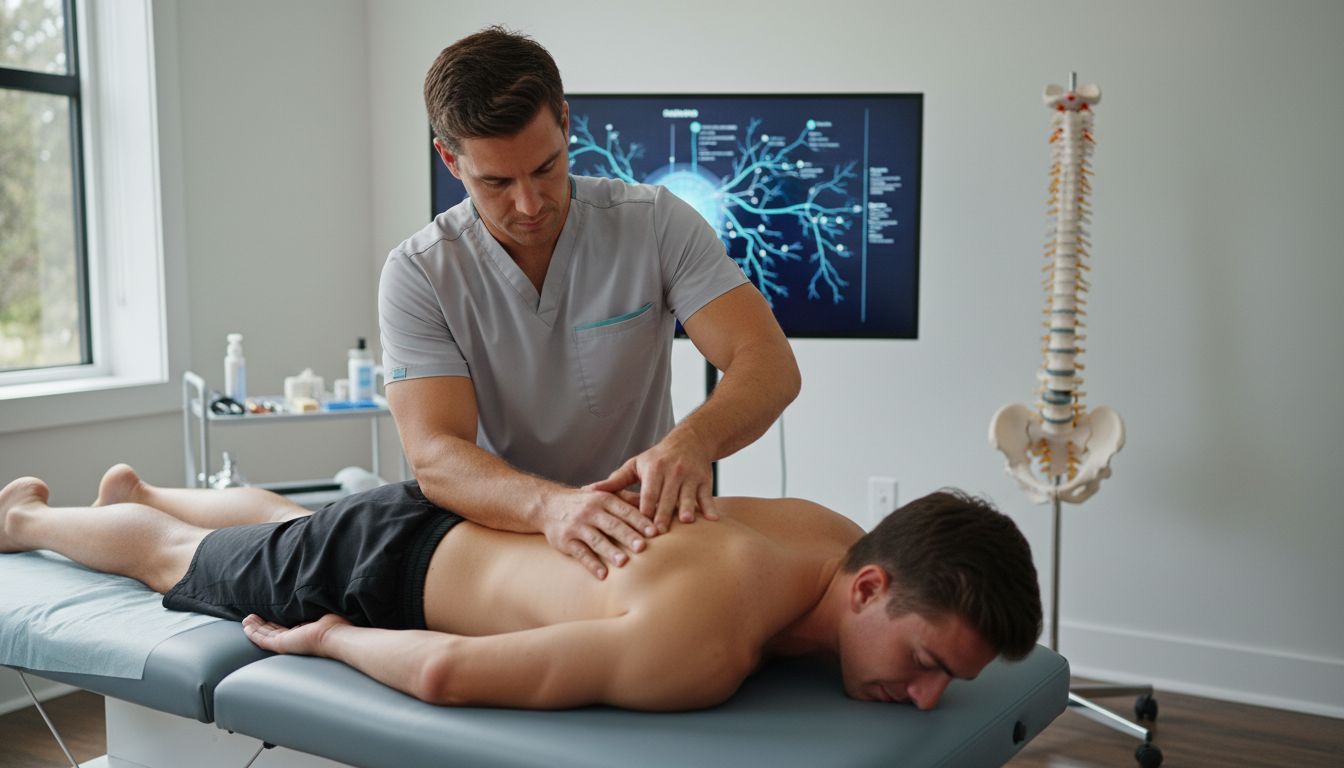How Chiropractic Aids Recovery: Complete Guide
- Dr Nathan Bridger

- 6 days ago
- 7 min read

Over 70 percent of adults experience musculoskeletal pain at some point in their lives, making recovery solutions a top concern. When pain lingers or limits your movement, it impacts everything from work to your favorite activities. Chiropractic recovery offers a pathway that focuses on long-term healing and improved function rather than just masking symptoms. This approach helps you understand how addressing the whole body can lead to greater mobility, fewer setbacks, and stronger overall health.
Table of Contents
Key Takeaways
Point | Details |
Holistic Approach | Chiropractic recovery addresses not just pain, but the interconnectedness of musculoskeletal health and overall wellness. |
Spinal Adjustments | These techniques improve spinal alignment and nervous system function, playing a crucial role in enhancing mobility and reducing pain. |
Soft-Tissue Therapies | Manual techniques target muscle and connective tissue, promoting healing and preventing future injuries through strategic interventions. |
Comprehensive Recovery Support | Incorporating quality sleep, nutrition, and rehabilitation exercises is essential for optimising recovery and boosting resilience. |
What chiropractic recovery means
Chiropractic recovery is a holistic approach to healing that goes far beyond simply addressing pain. According to BetterHealth, it focuses on diagnosing and treating musculoskeletal issues, with a particular emphasis on spinal health and overall functional improvement.
At its core, chiropractic recovery involves strategic manual therapies designed to restore proper movement, reduce inflammation, and support the body’s natural healing processes. HealthDirect confirms that chiropractors utilize techniques like spinal manipulation and targeted massage to address underlying musculoskeletal conditions. These interventions aim to:
Restore joint mobility
Reduce muscular tension
Improve nervous system communication
Enhance overall physical performance
Unlike traditional medical treatments that often focus solely on symptom management, chiropractic recovery takes a comprehensive view of your body’s interconnected systems. Our approach recognises that pain or dysfunction in one area can significantly impact your entire musculoskeletal structure. We don’t just treat the immediate problem - we help you understand and address the root causes, empowering you to achieve sustainable, long-term wellness.
For active individuals and athletes in our community, chiropractic recovery means proactive care that supports your body’s resilience. Whether you’re managing a sports injury, recovering from workplace strain, or seeking to optimise your physical performance, chiropractic care advantages for active lifestyles can be a game-changing component of your health strategy.
Spinal adjustments: alignment and nerve health
Spinal adjustments are a precise and targeted approach to improving musculoskeletal health by addressing the fundamental connections between spinal alignment and nervous system function. According to Chiro Australia, these adjustments involve the strategic application of controlled force to spinal joints, with the goal of restoring proper alignment and reducing nervous system interference.
The core principle of spinal adjustments is to correct misalignments that can disrupt normal joint movement and nerve communication. Royal Australian College of General Practitioners confirms that these techniques aim to:
Restore proper joint mobility
Reduce nerve system interruptions
Alleviate pain and tension
Improve overall neurological function
When your spine is misaligned, it can create significant stress on your nervous system. Think of your spine like a complex highway system where nerves are the critical communication routes.

Any blockage or misalignment can disrupt the smooth flow of signals between your brain and body, potentially leading to pain, reduced mobility, and compromised overall health.
For active individuals dealing with workplace strain or sports-related challenges, understanding spinal adjustments can be transformative. Injury prevention strategies play a crucial role in maintaining long-term physical wellness, and precise spinal adjustments are a key component of proactive healthcare.
Soft‑tissue therapies for healing
Soft-tissue therapies represent a critical component of comprehensive chiropractic care, focusing on healing and restoring muscular and connective tissue function. According to Chiro Australia, chiropractors employ a range of manual techniques and low-force interventions designed to address muscle and joint issues, promoting targeted healing and reducing discomfort.
These soft-tissue therapies encompass multiple specialized approaches that work synergistically to support your body’s natural recovery processes. HealthDirect confirms that techniques like therapeutic massage can significantly alleviate muscle tension and support comprehensive musculoskeletal healing. Key techniques include:
Deep tissue massage
Trigger point therapy
Myofascial release
Active release techniques
Instrument-assisted soft tissue mobilisation
Understanding soft-tissue therapy is about recognising the interconnected nature of your muscular and skeletal systems. These techniques aren’t just about temporary relief - they’re strategic interventions that help restore proper movement patterns, reduce inflammation, and support long-term tissue health. By addressing underlying muscular restrictions and imbalances, soft-tissue therapies help prevent future injuries and enhance overall physical performance.
Here’s a comparison of main chiropractic recovery therapies and their key benefits:
Therapy Type | Main Focus | Key Benefits |
Spinal Adjustments | Spinal alignment Nerve health | Restores joint mobility Reduces nerve disruption Improves neurological function |
Soft‑Tissue Therapies | Muscle and connective tissue care | Alleviates tension Reduces inflammation Prevents injury |
Lifestyle Support | Sleep Nutrition Movement | Promotes tissue repair Boosts resilience Supports long-term wellness |
For active individuals and athletes in our community, neck pain relief methods can be particularly transformative. Our approach goes beyond symptom management, focusing on comprehensive tissue rehabilitation that supports your body’s natural healing capabilities and helps you return to the activities you love with improved strength and mobility.
Recovery support: sleep, nutrition, movement
Recovery is a holistic process that extends far beyond clinical treatments, encompassing critical lifestyle factors that directly impact your body’s healing potential. Chiro Australia emphasises that chiropractors provide comprehensive guidance on lifestyle elements including exercise and nutrition to support overall health and enhance musculoskeletal recovery.
Effective recovery support requires a strategic approach that integrates three fundamental pillars:
Quality sleep for tissue repair
Targeted nutritional intake
Purposeful movement and rehabilitation
Sleep represents the body’s primary regeneration period, where cellular repair and hormonal rebalancing occur. Nutrition provides the essential building blocks for tissue healing, while carefully structured movement helps maintain flexibility, strength, and prevents future injuries. Chiro Australia highlights the importance of maintaining spinal health through regular exercise and proper posture, which chiropractors can support through tailored interventions and personalised advice.
For active individuals managing demanding physical routines, understanding these recovery principles becomes crucial. Injury prevention strategies play a vital role in long-term wellness, ensuring that your body remains resilient, adaptable, and prepared for whatever challenges you choose to pursue.
Risks, safety and when to avoid
Chiropractic care is a safe and effective treatment approach when performed by qualified professionals, but understanding potential risks and limitations is crucial for patient safety. HealthDirect emphasises the importance of discussing existing health conditions with your chiropractor to ensure appropriate and safe treatment.
Chiro Australia confirms that chiropractic adjustments are safe, utilising skill and precise techniques rather than brute force. However, a comprehensive pre-treatment assessment is essential to identify any potential contraindications or individual risk factors that might impact treatment effectiveness and safety.
For those with complex medical histories or ongoing health concerns, consulting injury prevention strategies can provide additional insights. Our approach prioritises patient safety, ensuring that every treatment is tailored to your unique physiological needs and current health status.
Alternatives and complementary approaches
Chiropractic care represents a dynamic component of comprehensive healthcare, often working in tandem with other treatment modalities to provide holistic healing solutions. Royal Australian College of General Practitioners highlights that chiropractic interventions can be effectively integrated into a multidisciplinary approach, particularly for managing complex musculoskeletal conditions like low back pain.
The complementary approaches to chiropractic care encompass a range of therapeutic strategies that can work synergistically to support your body’s healing process. These may include:
Physiotherapy
Remedial massage
Osteopathy
Acupuncture
Exercise rehabilitation
Nutritional counselling
Sports medicine interventions
Understanding these alternative approaches is about recognising that healing is rarely a one-size-fits-all journey. Each therapeutic method offers unique benefits, and the most effective treatment plans often involve a collaborative, integrated strategy that addresses your specific physical needs and health goals. The key is creating a personalized approach that combines different techniques to maximise recovery and long-term wellness.
For active individuals seeking comprehensive care, injury prevention strategies can provide additional insights into how different therapeutic approaches can work together to support your body’s resilience and performance.
Rediscover Your Best Movement with Expert Chiropractic Recovery
The journey outlined in “How Chiropractic Aids Recovery: Complete Guide” highlights challenges such as spinal misalignment, muscular tension, and the need for comprehensive recovery support including sleep and nutrition. If you are experiencing persistent pain, reduced mobility, or frustration from recurring injuries, these are clear signs your body needs precise intervention. At North Fremantle Chiropractic we understand that true recovery goes beyond quick fixes. We focus on spinal adjustments, soft-tissue therapies, and tailored lifestyle advice that directly addresses issues like nerve disruption and muscular imbalance to help you move confidently again.
Combining elite sports-focused chiropractic with real-world strength and conditioning means our care is built around meaningful results rather than temporary relief. Whether you are a weekend warrior dealing with neck pain or an athlete aiming to prevent workplace strain injuries, our hands on, movement based approach is designed to build resilience long term.
Ready to take control of your recovery and get back to what you love? Explore how our chiropractic solutions can support your healing journey today and discover the empowering difference expert care can make.

Don’t wait for pain to hold you back. Visit North Fremantle Chiropractic now to schedule a consultation and start personalised treatment crafted for your unique needs. Your path to improved function and lasting wellness starts here.
Frequently Asked Questions
What is chiropractic recovery?
Chiropractic recovery is a holistic approach focused on diagnosing and treating musculoskeletal issues, especially spinal health, and improving overall functional performance through strategic manual therapies.
How do spinal adjustments support recovery?
Spinal adjustments restore proper alignment and reduce nerve interference, which helps improve joint mobility, alleviate pain, and enhance overall neurological function.
What role do soft-tissue therapies play in chiropractic care?
Soft-tissue therapies alleviate muscle tension and address musculoskeletal injuries through techniques like deep tissue massage and trigger point therapy, promoting healing and preventing future injuries.
Why are lifestyle factors important in chiropractic recovery?
Lifestyle factors such as quality sleep, nutrition, and purposeful movement support the body’s healing potential and play a crucial role in the overall recovery process.
Recommended

Comments